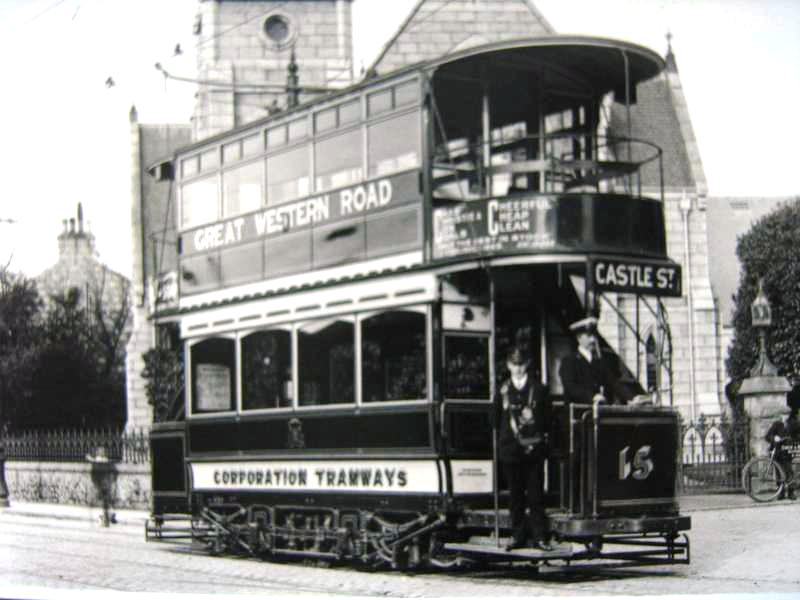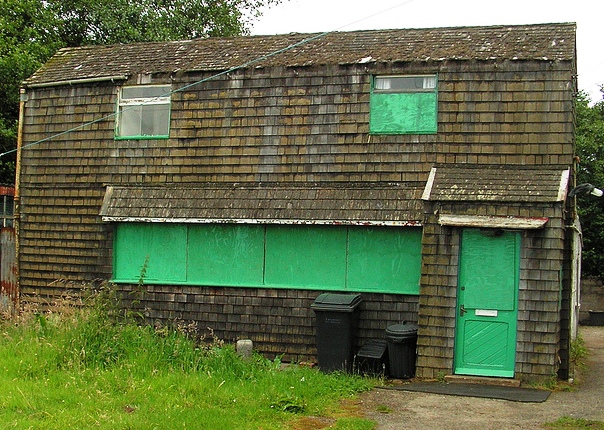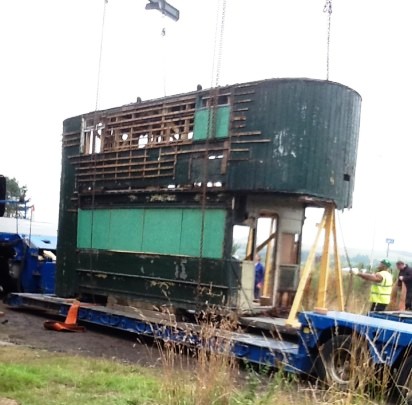Falcon & The Pheonix

Resurrection! – One of the Last Survivors escapes the Flames
An Aberdeen Tram body which had been discovered in use as a domestic ‘house’ near Loiriston Loch called Cedar Cottage, Wellington Road, Cove – the only surviving Tram left in Aberdeen. A band of enthusiasts rescued the Body and hope to start restoring the Tram to its full former livery & glory. In the intervening months the group have had to overcome many hurdles and they surmounted the last of these as the Tram was carefully removed from its somewhat incongruous resting place for a glorious Phoenix like rebirth after Full Restoration.

The No.15 Tram is possibly 1 of 6 from the batch of c.1901 Topped Double-deckers with 6ft Wheel Base. and was one of the 1st Electric Trams made by Brush Electrical Engineering Co., Falcon Works. Loughborough to be operated by Aberdeen Corporation Transport. Like some other Tram bodies following their retirement, it was purchased and bizarrely converted into linear Living Accommodation by someone in need of a cheap 1930s depression times ‘home’ and aptly named Cedar ‘Cottage’, where it had remained cocooned in total obscurity until now. The Tram body was cleaned and carefully reinforced for removal by the dedicated band of enthusiasts. It was then extricated from the exterior cedar tile cladding that masked the core of the structure of the building. With the help of a Crane and a Haulier, the body was then removed from the Site it had occupied since 1930 and placed on a low Loader. The lift entailed the use of a large 50-ton crane although the Tram in its present modified state weighs only 4/5 Tons. The main difficulty was that it had to be lifted over Electricity Cables and these were ‘isolated’ as a precaution and the Tram was then safely removed from its enforced ‘halt’ of 83-yrs. It was then placed onto the Low Loader and will re-start its life with a full restoration.
There are plans underway for a dedicated feature website which will include a History of this Tram and its ilk, which will be an ongoing story, as well as a section on the social importance of the Trams in Aberdeen’s past History, a Picture Gallery, ongoing News of the project, and a chance for the public to make Donations towards this unique restoration. It is expected that the Website will be quickly established as the group were anxious for the Tram to be safely preserved before going ahead with this publicity. The Tram is now in secure accommodation, having moved under relative secrecy due to the danger of possible vandalism before leaving its former site. It now starts its long and painstaking journey to full recovery as a passenger vehicle. Watch this space!

The casually improvised, fully camouflaged and narrow depth Cedar ‘Cottage’ was a ‘shanty’ built around the body and frame of a cocooned Double-decker Tram set on a concrete slab. It then had its seating removed to provide cheap compact living accommodation for a quirky recluse for limited outlay during hard times between the wars in a remote location. The exterior of the Tram was pitched roofed and squared off, slatted with timbers and then clad with cedar wood tiles. Cedar Shingles & Shakes Roof Tiles have been used for 100s of years and have proven their durability in all kinds of climates. They can be used to create individual buildings, whether traditional or modern, and their rich, warm colour and texture blend beautifully in any natural environment. The natural effects of ageing & weathering give the Shingles & Shakes, in time, an attractive silvery grey colour. The Site still became something of an eyesore with long neglect, and several random out-houses erected around it. A Site well overdue for Demolition and re-Development.
– ach – jist knocket doon min.

The Tram is now in its new home at the Dundee Transport Muesum. Immediate priorities are to remove the green tongue and groove boarding which was possibly its 1st stage as a shanty home modification, and complete an assessment of the work required and how it will be phased. It is fortunate that all missing parts can be replicated from patterns elsewhere on the Body; the lower deck pillars and beams, the missing upper deck bulkhead, and the top deck sides, for example. A staircase for a sister car No.14 exists and patterns can be made from that.
Aberdeen Tram Restoration
So far the remaining matchboarding, the remaining Cedar Tiles and associated framing, and almost all of the House Conversion timber has now been removed from the Body as a 1st step in returning the Tram to more “Tram-like” condition. Elsewhere a sample rib from the lower Saloon has been removed to provide a pattern, the Upper Deck quarter lights on one side have been removed, the upper part of the surviving Top Deck exterior panel has been removed and is to be submitted for expert examination to identify the Route Branding hidden underneath the flaking paint. The shoring up timbers in the Lower Deck have also been partly removed. No further progress has yet been made on identifying the Tram but one of quarter lights has been cleaned down and does have the remains of painted letting/numerals but at this stage cannot be clearly identified. It is hoped that when these are identified some clues may be revealed as to the number of the Tram.
